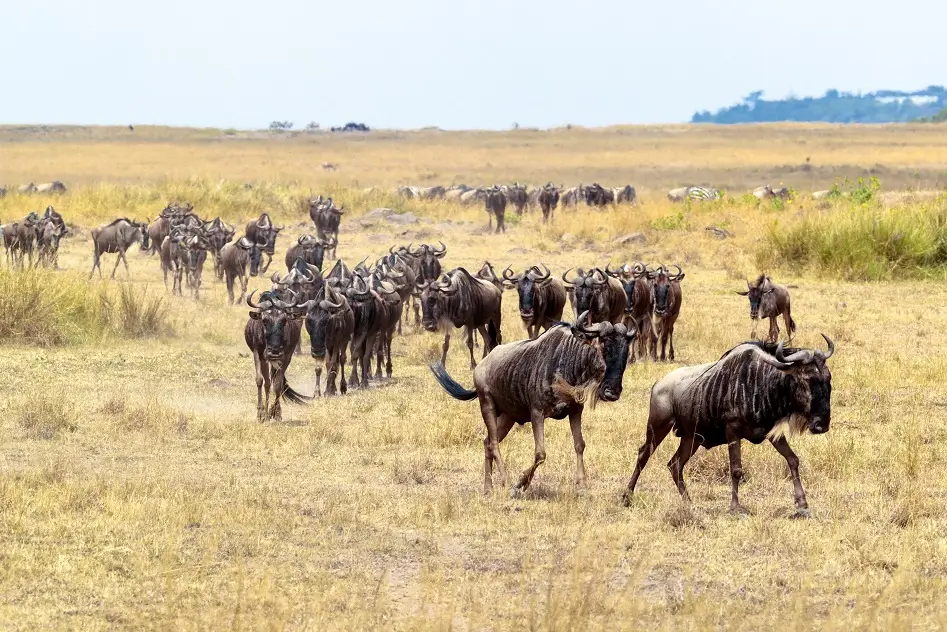Every year, millions of wildebeests, zebras, and gazelles move across the grasslands of East Africa. This journey is called the Great Migration, and it happens mostly in the Serengeti region of Tanzania and Kenya. But one big question remains on everyone’s mind: Why Does the Great Migration in Africa Occur?
The answer lies in the animals’ need to survive. The wildebeest migration is not random. It follows the rain and the growth of fresh grass. This means the animals move in a big loop every year, crossing the Serengeti and Maasai Mara regions. This pattern of movement forms what is often called the Serengeti-Mara ecosystem.
This seasonal migration is guided by the weather, food, and water. If they do not move, then they cannot eat. Their survival instincts tell them when and where to go. People around the world are amazed by this event, mostly called Africa’s natural wonder. Wildlife photographers, conservationists, and safari-goers flock to East Africa to witness this unique, cyclical movement of animals.
When Does the Great Migration Happen? (Timeline by Season)
The Great Migration follows a predictable pattern that happens every year, and it is all about survival. The animals move across East Africa in search of fresh grass and water, and each part of the journey is important.
January to March – Calving Season
The migration starts with the calving season in February. This is when many wildebeests give birth to their babies. It is a busy time as thousands of calves are born in the southern Serengeti. The warm, wet environment helps the babies grow strong, and the herds stay here for the start of the year. It is also a dangerous time because predators like lions, hyenas, and cheetahs are waiting to hunt. This is a key period in the predator-prey cycle that maintains the balance of the ecosystem.
April to June – Moving North
By April, the animals begin to move northward as the dry season starts to take over. They head toward the Maasai Mara in Kenya in search of food and water. The rains are mostly over, so the animals follow the green grass that grows after the rains. They travel in large groups, constantly on the move, and always looking for a place to graze. Elephants and other herbivores also benefit from the availability of fresh pastures during this phase. This movement reflects both the cause of the Great Migration and why the Great Migration occurs in Africa.
July to September – River Crossings
The most dramatic part of the migration happens in July through September, when the animals reach the Mara River. This is known as the July river crossing. The wildebeests must cross the river to reach better grazing lands in Kenya. This is a dangerous time because the river is full of crocodiles. Many animals are caught by predators, but the migration continues as they fight to survive. Viewing the river crossings from a boat safari or nearby ridge offers one of the most thrilling safari experiences in the world.
October to December – Dry Season Survival
By October, the animals begin to head back south. The dry season has set in, and the herds need to return to the Serengeti for the final part of the cycle. The herds will travel through dry areas in search of water and fresh grass. This is a tough time, as survival depends on finding enough food and avoiding predators. As the year ends, the rain begins again, triggering the start of a new migration loop. This return journey highlights why the Great Migration occurs in Africa and how the climate dictates animal movement.
Why Does the Great Migration in Africa Occur?
Why does the Great Migration occur in Africa? The Great Migration is all about survival. For millions of wildebeests, zebras, and gazelles, it is a journey driven by the need for food, water, and breeding. The animals would not be able to survive in such a harsh environment without migration.
Food and Water Needs – one of the cause of great migration
The most important factor behind the Great Migration is the need for food and water. The animals move to find fresh grass that grows after the rains. In the dry season, the grasses in certain areas become scarce, so the herds have to travel long distances to find better grazing lands.
This is why the migration follows the rain patterns. When the rains come, new grasses begin to grow, and the herds are drawn to these areas. In addition to food, water is also a major concern. During the dry season, water sources can dry up, which makes it even more difficult for the animals to survive. The ecological rhythm of the migration helps the animals stay near water sources while moving through different regions. Their movement is also linked to the changing availability of water, which is necessary for their survival.
Breeding and Calving – another cause of great migration
Another important reason for the migration is breeding. The animals must give birth at the right time to ensure that their young have the best chance of survival. Calving season, which happens in February, occurs in the southern Serengeti where there is plenty of fresh grass. The warm, wet environment helps the young calves grow strong, and the predators are less active during this time.
After the calves are born, the herds move northward in search of better grazing, and they continue to follow the rains and the availability of fresh food. This also marks the beginning of the next generation of animals that will participate in the migration cycle.
Role of Rain Patterns and Fresh Grazing Land
Rain patterns are a climate trigger for the Great Migration. The animals rely on the seasonal rains to signal when and where to move. As the rains bring new grasses, the herds follow them. They know that the best grazing lands are found where the rain has been. The arrival of the rains also marks the start of a new cycle, and the herds follow these climate triggers to stay alive.
Predator-Prey Cycle
Another important part of the migration is the predator-prey cycle. As the herds move, predators like lions, crocodiles, hyenas, and cheetahs follow them, hoping to catch prey. The migration creates a balance in the ecosystem, with predators waiting for weak or sick animals to fall behind.
However, the herds are also able to adapt to the dangers of being preyed upon by moving together in large groups. This strategy helps protect the young and weak animals from being picked off. The presence of scavengers and secondary predators also adds to the complexity of the migration’s food web.
Best Places to Witness the Migration (For Tourists)
If you are looking to experience one of nature’s most incredible events, the Great Migration safari is a must. Different parts of the journey offer unique opportunities to witness the wildebeests and other animals in action.
Best National Parks for Viewing the Migration
Some of the best places to watch wildebeest migration include Tanzania’s Serengeti National Park and Kenya’s Maasai Mara National Reserve. Both parks are famous for their role in the migration and offer amazing opportunities for tourists. The Serengeti is where the migration begins, and the Maasai Mara is where the animals cross into Kenya. These areas provide excellent game viewing, as the animals are always in motion.
You can also choose from different safari lodges and camps that are located near the migration routes, so you are sure to get the best experience. Options range from luxury lodges to mobile camps that move with the herds.
Tips for Viewing River Crossings
The river crossings are one of the most dramatic moments in the Great Migration. To get the best view, consider taking a boat safari or viewing from a nearby ridge. The Mara River is the site of some of the most famous crossings, so arriving early in the morning will give you a better chance of witnessing the action. Patience and timing are essential, as the crossings are unpredictable.
Frequently Asked Questions (FAQs)
How far do wildebeest travel?
Wildebeests travel up to 1,000 miles each year during the Great Migration. They move between the Serengeti in Tanzania and the Maasai Mara in Kenya, following the rains to find fresh grazing land and water.
Do animals ever return the same route?
Yes, animals do return along the same route each year. They follow the same general path as they migrate between the Serengeti and the Maasai Mara.
Is the migration dangerous?
Yes, the migration can be dangerous. Animals face many challenges, including predators like lions, crocodiles, and hyenas. But these dangers are part of the natural cycle that helps to keep the ecosystem in balance.
Bonus: Quick Comparison Table – Serengeti vs. Maasai Mara
| Feature | Serengeti | Maasai Mara |
|---|---|---|
| Country | Tanzania | Kenya |
| Starting Point | Southern Serengeti | Northern Mara |
| Key Months | Jan – June (Calving, Early Move) | July – Oct (River Crossings) |
| Signature Event | Calving Season | Mara River Crossing |
| Predators Present | Lions, Hyenas, Cheetahs | Lions, Crocodiles, Leopards |
| Accessibility | Multiple Safari Routes & Camps | Well-developed Tourist Facilities |
By understanding the deeper reasons behind the Great Migration and knowing the best ways to experience it, travelers and nature lovers can appreciate one of the planet’s most awe-inspiring natural events even more.




